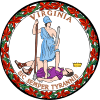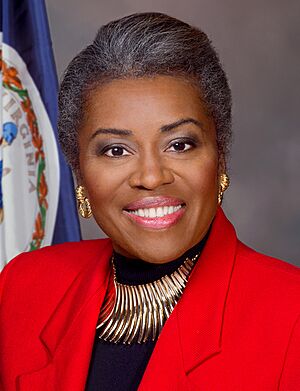Lieutenant Governor of Virginia facts for kids
Quick facts for kids Lieutenant Governor of the Commonwealth of Virginia |
|
|---|---|

Seal of the Commonwealth of Virginia
|
|
| Style | The Honorable |
| Term length | Four years, no term limits |
| Inaugural holder | Shelton Leake |
| Formation | 1852 |
| Website | www.ltgov.virginia.gov/ |
The Lieutenant Governor of Virginia is an important leader in the state of Virginia. This person is chosen by voters every four years, at the same time as the Governor and the Attorney General.
Currently, Winsome Earle Sears holds this position. She was elected in 2021. She is the first woman and the second person of color to serve as Lieutenant Governor in Virginia. The Governor and Lieutenant Governor are elected separately, so they might belong to different political parties.
The Lieutenant Governor has several key roles. They lead the Senate of Virginia meetings and are next in line to become Governor. This means if the Governor leaves office for any reason, the Lieutenant Governor steps in. In Virginia, a Governor cannot serve two terms in a row, but the Lieutenant Governor can, and there's no limit to how many terms they can serve.
Contents
What is the Lieutenant Governor's Role?
The Lieutenant Governor of Virginia is a special leader who helps run the state government. They are chosen by the people of Virginia in an election.
History of the Office
The idea of a Lieutenant Governor in Virginia goes way back to the 1630s. At that time, the British King or Queen would appoint helpers for the governors of the Colony of Virginia. These helpers were part of a group called the Governor's Council. One person in this group was chosen as the governor's deputy, or lieutenant governor. This person would take over if the governor was away.
After the American Revolution, the Virginia Constitution of 1776 changed things, and the council was removed.
The modern office of Lieutenant Governor was created by the Virginia Constitution of 1851. This new constitution said that the people would vote for the Lieutenant Governor. It also made the Lieutenant Governor the leader of the Virginia Senate. Before this, the Senate chose its own leader.
During the American Civil War, Virginia had two different governments, so there were different Lieutenant Governors. After the war, from 1865 to 1870, military generals appointed the Lieutenant Governors. In 1870, Virginia rejoined the United States, and since then, the people have voted for their Lieutenant Governor. A new constitution in 1870 gave the Lieutenant Governor the power to break ties in Senate votes.
Virginia has had important "firsts" in this office. Douglas Wilder became Virginia's first black Lieutenant Governor in 1986. Winsome Sears, who took office on January 15, 2022, is the first woman to hold the position.
How the Lieutenant Governor is Elected
The Lieutenant Governor is one of three top leaders in Virginia chosen by voters. The other two are the Governor and the Attorney General. People vote for the Lieutenant Governor separately from the Governor. This means they don't have to be from the same political team. There are no limits on how many terms a Lieutenant Governor can serve. If the person elected as Governor cannot take office, the Lieutenant Governor-elect becomes Governor instead.
Powers and Duties
The Constitution of Virginia says that the Lieutenant Governor leads the Senate. If the Lieutenant Governor is not there, another leader called the president pro tempore takes over. The Lieutenant Governor can only vote in the Senate if there's a tie. This power usually applies to most laws. However, there have been discussions about whether this tie-breaking power applies to big decisions like changing the constitution or approving people the Governor wants to appoint. These questions have not been fully decided in court.
The constitution also states that if the Governor's office becomes empty because of death, resignation, or other reasons, the Lieutenant Governor takes over as Governor. State laws also allow the Lieutenant Governor to serve on various state groups and committees. The Virginia General Assembly can remove the Lieutenant Governor from office if they do something wrong.
The Lieutenant Governor's office is in the Oliver Hill Building in Richmond, Virginia. Their pay is decided by law and cannot be changed during their term. As of 2021, the yearly salary was $36,321. Since this is a part-time job, most Lieutenant Governors have other jobs unless they are already wealthy or retired.
List of Virginia's Lieutenant Governors
Here is a list of the people who have served as Lieutenant Governor of Virginia since the modern office was created.
- Parties
Conservative (1 lieutenant governor) Democrat (31 lieutenant governors) Independent (1 lieutenant governor) Republican (7 lieutenant governors) Union (2 lieutenant governors)
| # | Image | Name | Party | Term | Governor | Notes | Source |
|---|---|---|---|---|---|---|---|
| 1 | Shelton Leake | Democratic | 1852–1856 | Joseph Johnson | |||
| 2 | Elisha W. McComas | Democratic | 1856–1857 | Henry A. Wise | |||
| 3 |  |
William Lowther Jackson | Democratic | 1857–1860 | Henry A. Wise | ||
| 4 |  |
Robert Latane Montague | Democratic | 1860–1864 | John Letcher | Richmond (Confederate) Government | |
| 5 |  |
Samuel Price | Democratic | 1864–1865 | William Smith | Richmond (Confederate) Government | |
| 6 |  |
Daniel Polsley | Union | 1861–1863 | John Letcher | Restored (Unionist) Government | |
| 7 | Leopold Copeland Parker Cowper | Union | 1863–1865 | John Letcher | Restored (Unionist) Government | ||
| 8 | 1865–1869 | William Smith Francis Harrison Pierpont Henry H. Wells Gilbert Carlton Walker |
|||||
| 9 |  |
John F. Lewis | Republican | 1869–1870 | Gilbert Carlton Walker | ||
| 10 |  |
John Lawrence Marye, Jr. | Conservative | 1870–1874 | Gilbert Carlton Walker | ||
| 11 |  |
Robert E. Withers | Democratic | 1874–1875 | James L. Kemper | ||
| 12 |  |
Henry Wirtz Thomas | Republican | 1875–1878 | James L. Kemper | ||
| 13 |  |
James A. Walker | Democratic | 1878–1882 | Frederick W. M. Holliday | ||
| 14 |  |
John F. Lewis | Republican | 1882–1886 | William E. Cameron | ||
| 15 |  |
John E. Massey | Democratic | 1886–1890 | Fitzhugh Lee | ||
| 16 |  |
James Hoge Tyler | Democratic | 1890–1894 | Philip W. McKinney | ||
| 17 |  |
Robert Craig Kent | Democratic | 1894–1898 | Charles Triplett O'Ferrall | ||
| 18 |  |
Edward Echols | Democratic | 1898–1902 | James H. Tyler | ||
| 19 |  |
Joseph Edward Willard | Democratic | 1902–1906 | Andrew J. Montague | ||
| 20 |  |
James Taylor Ellyson | Democratic | 1906–1918 | Claude A. Swanson William Hodges Mann Henry Carter Stuart |
||
| 21 |  |
Benjamin Franklin Buchanan | Democratic | 1918–1922 | Westmoreland Davis | ||
| 22 |  |
Junius Edgar West | Democratic | 1922–1930 | Elbert L. Trinkle Harry F. Byrd |
||
| 23 |  |
James H. Price | Democratic | 1930–1938 | John Garland Pollard George C. Peery |
||
| 24 |  |
Saxon Winston Holt | Democratic | 1938–1940 | James H. Price | died in office | |
| 25 |  |
William M. Tuck | Democratic | 1942–1946 | Colgate Darden | ||
| 26 | Lewis Preston Collins II | Democratic | 1946–1952 | William M. Tuck | died in office | ||
| 27 | Allie Edward Stokes Stephens | Democratic | 1952–1962 | John S. Battle | filled Collins's term | ||
| 28 |  |
Mills E. Godwin, Jr. | Democratic | 1962–1966 | Albertis Harrison | ||
| 29 |  |
Fred G. Pollard | Democratic | 1966–1970 | Mills Godwin | ||
| 30 |  |
J. Sargeant Reynolds | Democratic | 1970–1971 | Linwood Holton | died in office | |
| 31 |  |
Henry Howell | Independent | 1971–1974 | Linwood Holton | Completed Reynolds's term | |
| 32 |  |
John N. Dalton | Republican | 1974–1978 | Mills Godwin | ||
| 33 |  |
Chuck Robb | Democratic | 1978–1982 | John N. Dalton | ||
| 34 |  |
Dick Davis | Democratic | 1982–1986 | Chuck Robb | ||
| 35 |  |
Douglas Wilder | Democratic | 1986–1990 | Gerald Baliles | ||
| 36 |  |
Don Beyer | Democratic | 1990–1998 | Douglas Wilder George Allen |
||
| 37 |  |
John H. Hager | Republican | 1998–2002 | Jim Gilmore | ||
| 38 |  |
Tim Kaine | Democratic | 2002–2006 | Mark Warner | ||
| 39 |  |
Bill Bolling | Republican | 2006–2014 | Tim Kaine Bob McDonnell |
||
| 40 |  |
Ralph Northam | Democratic | 2014–2018 | Terry McAuliffe | ||
| 41 |  |
Justin Fairfax | Democratic | 2018–2022 | Ralph Northam | ||
| 42 |  |
Winsome Sears | Republican | 2022–present | Glenn Youngkin |
Timeline of Lieutenant Governors

See also
 In Spanish: Vicegobernador de Virginia para niños
In Spanish: Vicegobernador de Virginia para niños


